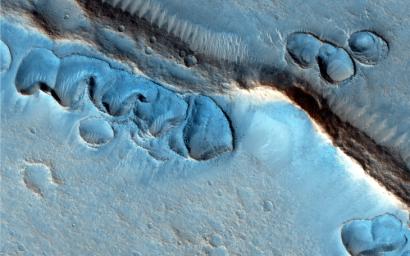
|
Mystery Martian Morphology of the Month
- Click the image above for a larger view
- Full-Res JPEG (2880 x 1800) (744.8 kB)
- Full-Res TIFF (2880 x 1800) (15.6 MB)
Caption:

Map Projected Browse Image
Click on the image for larger version
This image covers many shallow irregular pits with raised rims, concentrated along ridges and other topographic features . How did these odd features form?
One idea is that they could be from sublimation of shallow lenses of nearly pure ice, but why do the pits have raised rims? They can't be impact craters with such fortuitous alignment and irregular margins. They aren't wind-blown deposits because there are many boulders, too big to be moved by the wind. There are younger wind-blown drifts on top of the pits, and there's no clear connection to volcanism.
Some speculate that there were ancient oceans over this region--could that somehow explain these features? Ancient glaciation is another possibility, perhaps depositing ice-rich debris next to topographic obstacles. Future images of this region may provide clues, but for now this is a mystery.
Background Info:
HiRISE is one of six instruments on NASA's Mars Reconnaissance Orbiter. The University of Arizona, Tucson, operates the orbiter's HiRISE camera, which was built by Ball Aerospace & Technologies Corp., Boulder, Colo. NASA's Jet Propulsion Laboratory, a division of the California Institute of Technology in Pasadena, manages the Mars Reconnaissance Orbiter Project for the NASA Science Mission Directorate, Washington.
Cataloging Keywords:
| Name | Value | Additional Values |
|---|---|---|
| Target | Mars | |
| System | ||
| Target Type | Planet | |
| Mission | Mars Reconnaissance Orbiter (MRO) | |
| Instrument Host | Mars Reconnaissance Orbiter | |
| Host Type | Orbiter | |
| Instrument | High Resolution Imaging Science Experiment (HiRISE) | |
| Detector | ||
| Extra Keywords | Color, Crater, Impact, Map, Volcano | |
| Acquisition Date | ||
| Release Date | 2013-05-01 | |
| Date in Caption | ||
| Image Credit | NASA/JPL-Caltech/Univ. of Arizona | |
| Source | photojournal.jpl.nasa.gov/catalog/PIA17871 | |
| Identifier | PIA17871 | |
